Listen to SZ sounds, a journey of discovery
PROFILE
人物介绍
Swiss sound researcher and artist Marcel Zaes Sagesser teaches sound design at the School of Design at Southern University of Science and Technology. According to him, what makes the sounds in Shenzhen charming and special to him is that there are always urban sounds mixed with some natural sounds, and that the city "with a subtropical climate and a geographic location between the ocean and the hills, between the ocean and the continent” has influenced him in many ways.
来自瑞士的马塞尔•匝斯•萨格是南科大创新创意设计学院的助理教授。在这位声音研究者和艺术家看来,深圳声音的魅力和特别之处在于,城市的声音总是混合着自然的声音。在深圳生活一年多后,萨格教授认为这座有着亚热带气候的山海之城在很多方面影响了他。
Video and photos by Lin Jianping except otherwise stated 除另有说明外,本文所配视频及图片由林建平提供
Armed with headphones, a microphone, a windshield and a digital recording device, Marcel Zaes Sagesser captures sounds of Shenzhen: hoards of commuters in constant motion, impatient bike honks, yelling from street vendors’ loudspeakers, WeChat payment alerts, roaring buses, cars and trains, river flowing and bird chirping.
戴上耳机,手持一支麦克风、一个挡风罩,身背一台数字录音设备,马塞尔•匝斯•萨格教授记录着深圳的声音: 这里有通勤者的步履匆匆,不耐烦的自行车鸣笛,街头小贩扬声器里的叫卖,微信收款到账提醒,公交、汽车和地铁的疾驰,还有河流潺潺和鸟鸣啁啾。
“The charm of sound in part is exactly because it’s invisible but it’s everywhere; it’s all around us,” said Sagesser, an assistant professor in the School of Design at Southern University of Science and Technology (SUSTech).
“声音的魅力之一在于它看不见,但又无处不在,它就在我们身边。” 南方科技大学(以下简称“南科大”)创新创意设计学院助理教授萨格告诉记者。

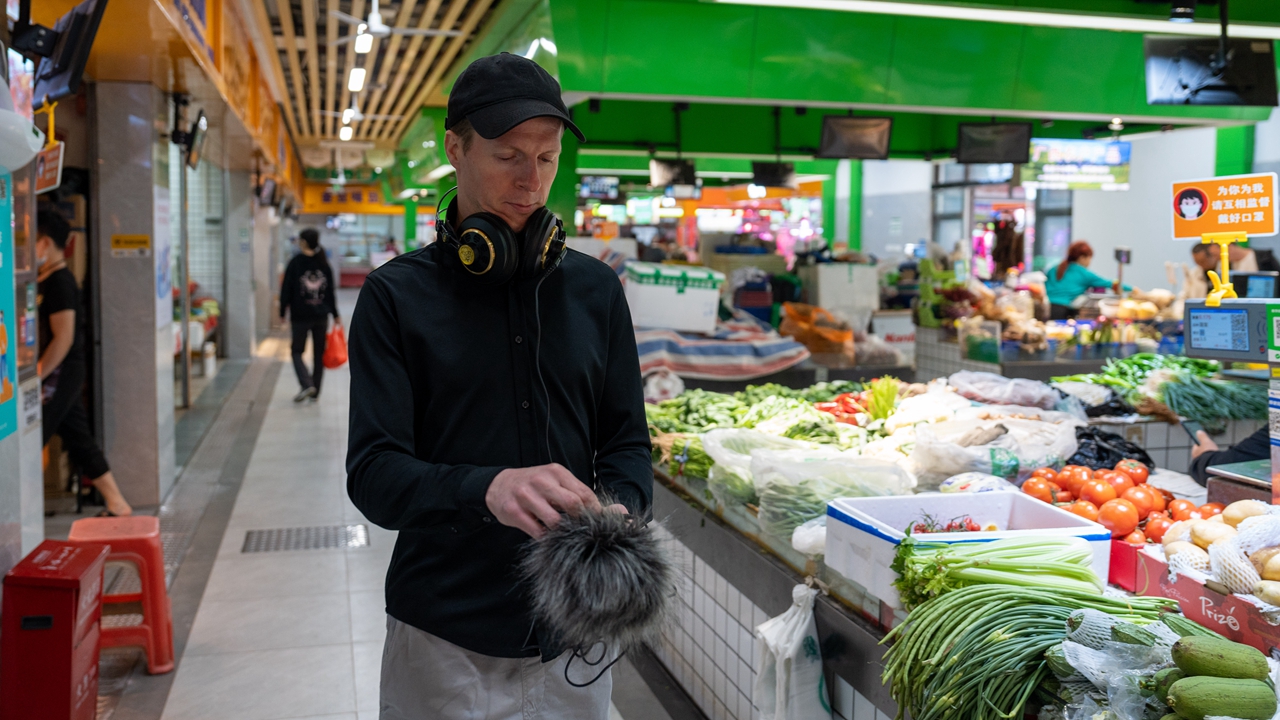
Marcel Zaes Sagesser collects sounds in a shopping area and a wet market in Nanshan District in late February.
马塞尔·匝斯·萨格于二月末在南山区的一个商场和一个农贸市场录音。
The Swiss sound researcher and artist moved to Shenzhen last year from the United States where he finished his Ph.D. at Brown University. He now teaches sound design for undergraduate students majoring in industrial design. He does field recording in nature and densely populated urban areas, then maps the sound recordings in computer software, and creates interactive sound maps of the city to understand how the sonic world in the city functions.
这位来自瑞士的声音研究者和艺术家去年在美国布朗大学取得了博士学位,现为南科大工业设计专业的本科生教授声音设计。他通常在大自然和人口稠密的城市里进行田野录音,然后用计算机软件处理,并绘制成交互式的城市声音地图,以了解城市中的声音世界。
Sagesser said that noise in Shenzhen is loud in urban areas but natural and environmental sounds are also very dominant in the soundscape of the city. “What is so charming, maybe special, about Shenzhen in sound for me is that there are always urban sounds mixed with some natural sounds. Like this very moment we hear traffic, we hear water but we also hear a lot of birds, so it’s not that the city and nature are two distinct parts; they are always mixed and blended.”
萨格教授说: “深圳声音的魅力和特别之处在于,城市的声音总是混合着自然的声音。就像此刻,我们听到了车水马龙,听到了河流声,但我们也听到很多鸟儿的叫声,城市和自然在这里是融为一体的。”
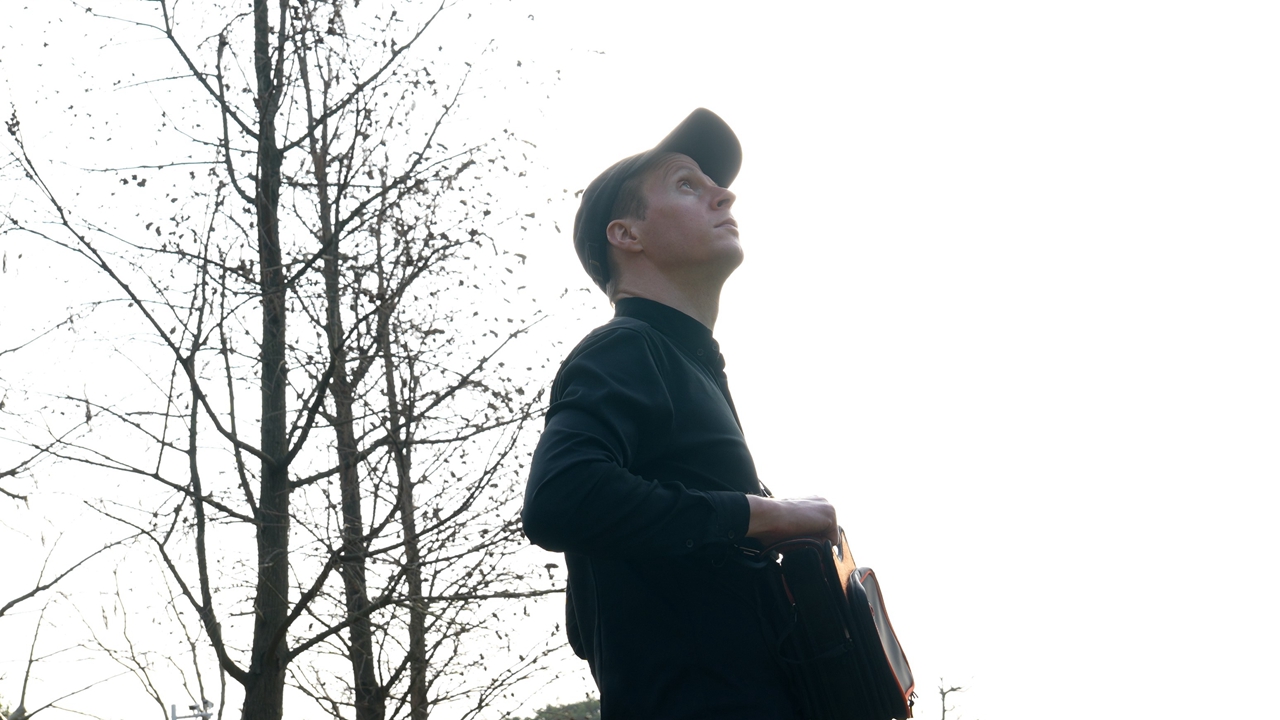
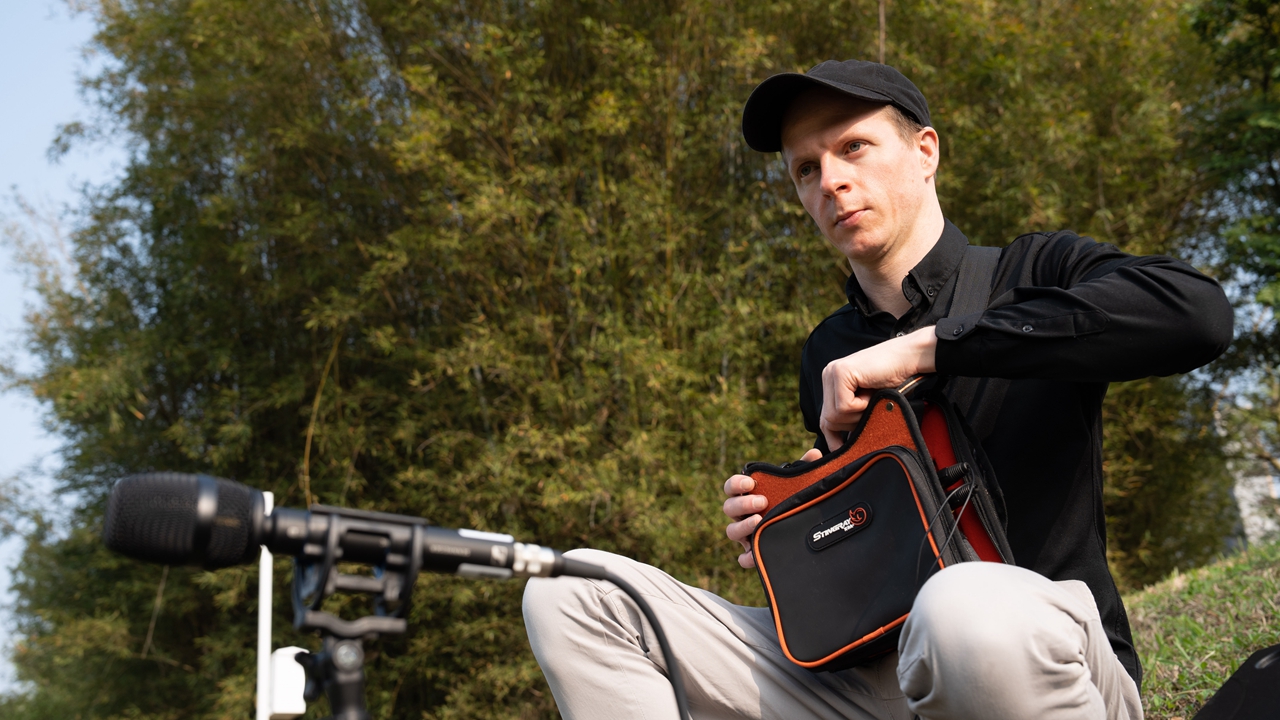
Sagesser does field recording in nature in Shenzhen.
萨格在深圳进行田野录音。
In Shenzhen, Sagesser collects sounds mostly in Metro stations, train stations, streets, sidewalks, shopping malls, supermarkets, wet markets and random places where there are a lot of people. He walks in the city with a microphone as a way to understand the city through sounds. This kind of working method, termed “sound walking,” focusing on listening to the environment while walking, was used in his and Xu Binghuang’s “Unwalking” project.
萨格教授平时主要在深圳的地铁站、火车站、街道、人行道、购物中心、超市、菜市场和人多的场所收集声音,手持麦克风在城市中行走,通过声音了解城市。这种边走边听的“声音漫步”工作方式,在他和许冰煌设计的“行步如影”项目中亦有体现。
The project was designed for the Pingshan subvenue exhibition of the ninth Bi-City Biennale of Urbanism\Architecture (UABB) last year. They had six student groups working on this project, with each group creating one sound work. Using ethnographic methods, they interviewed locals and tourists, and did field recordings at the centuries-old Hakka compound, the Dawan Ancestral Residence.
该项目为第九届深港城市\建筑双城双年展(深圳)的坪山分展场而设计。参与项目的学生被分成六个小组,每个小组创作一件声音艺术作品,他们用人类学的研究方法采访当地人和游客,并在拥有数百年历史的客家围屋大万世居进行田野录音。
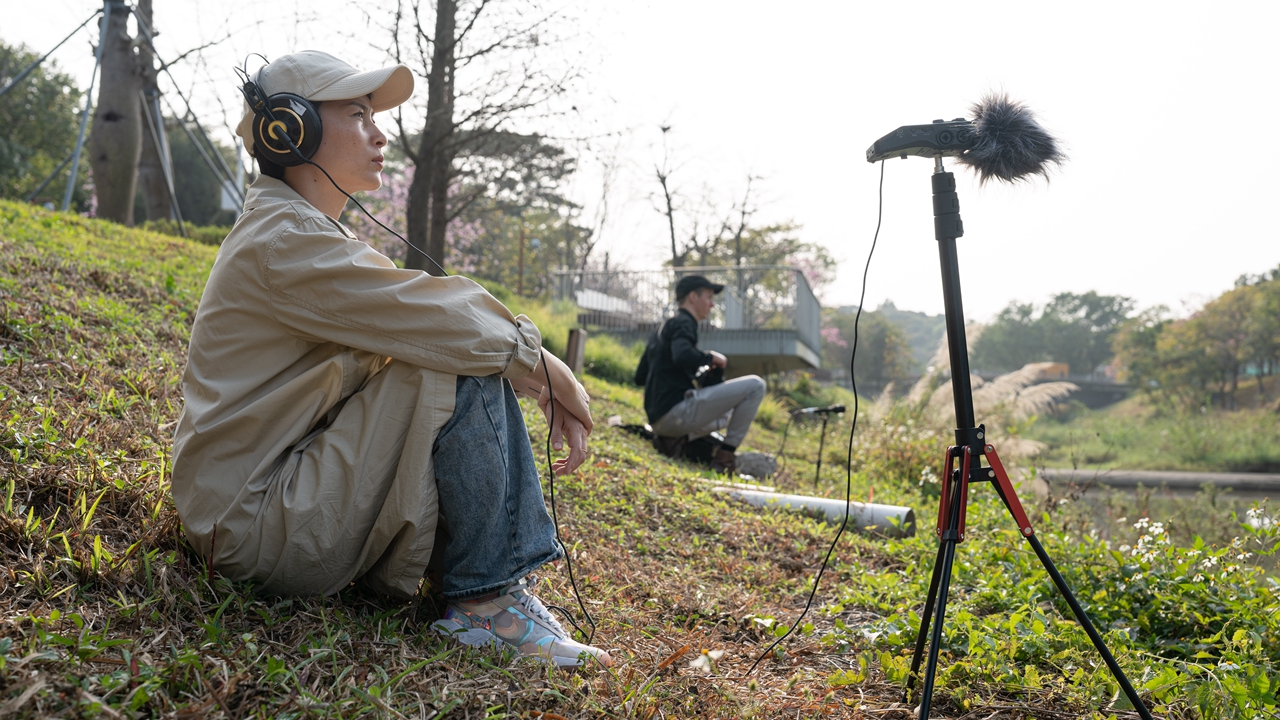
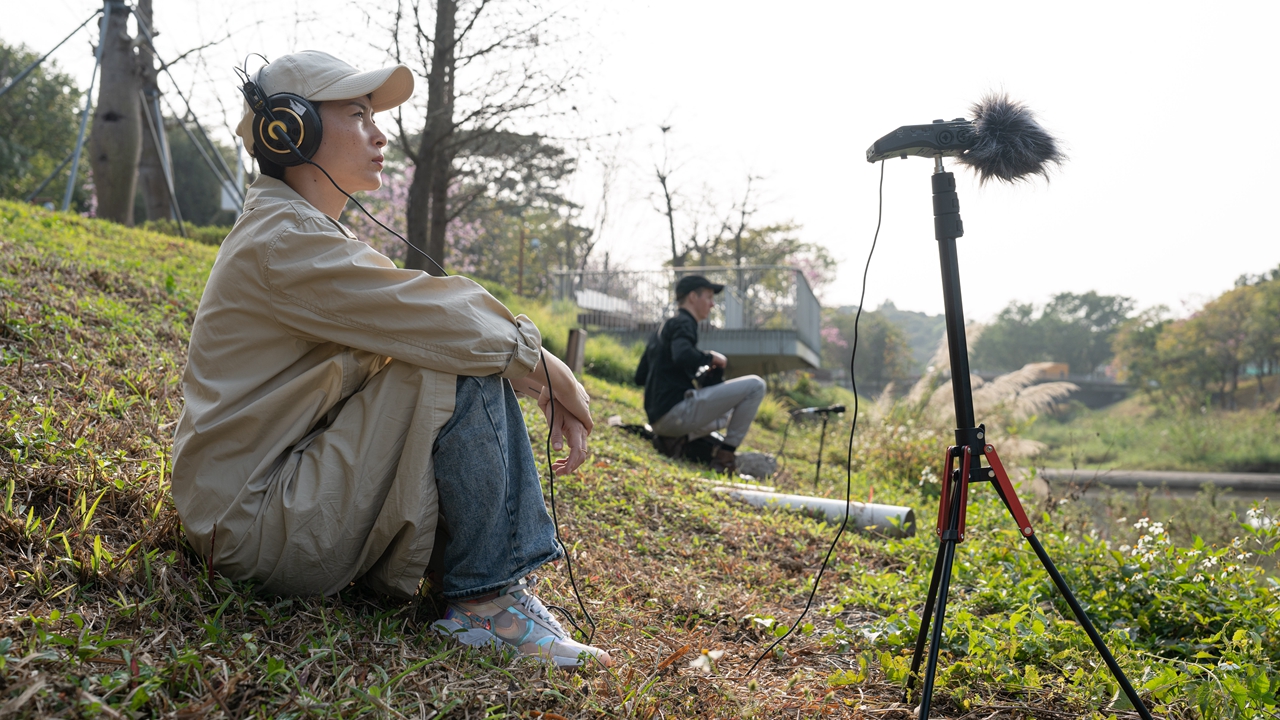
Xu Binghuang (front), a research assistant in Marcel Zaes Sagesser’s team at SUSTech’s School of Design, does field recording with Sagesser at the campus.
南科大设计学院研究助理徐冰煌(前)和萨格在南科大校园里录音。
“Sound was much more blurred at the compound because inside it you heard the traffic from outside and when you were outside you still heard the birds’ sounds from inside,” said Sagesser, adding that they also recorded in urban villages, at some workshops and by the Pingshan River.
“身处大万世居,你可以听到墙外的车流声,而当你走到外面,你仍然能听到大万世居里的鸟鸣,声音都是交织的,”萨格教授说。
The final sound works are associated with both the past, like the traditional craft sounds, and the future, with some sounds created by students using synthesizers in the studio, bringing hidden histories and stories to life and helping listeners to see this old site in a new light.
学生们还在坪山的城中村、工作坊和坪山河边采集声音,最终的声音作品再现了过去,又连接了未来,传统生活里的声音与后期合成的电子音融合,栩栩如生地讲述不同时期的故事,使听众从新的视角理解大万世居。

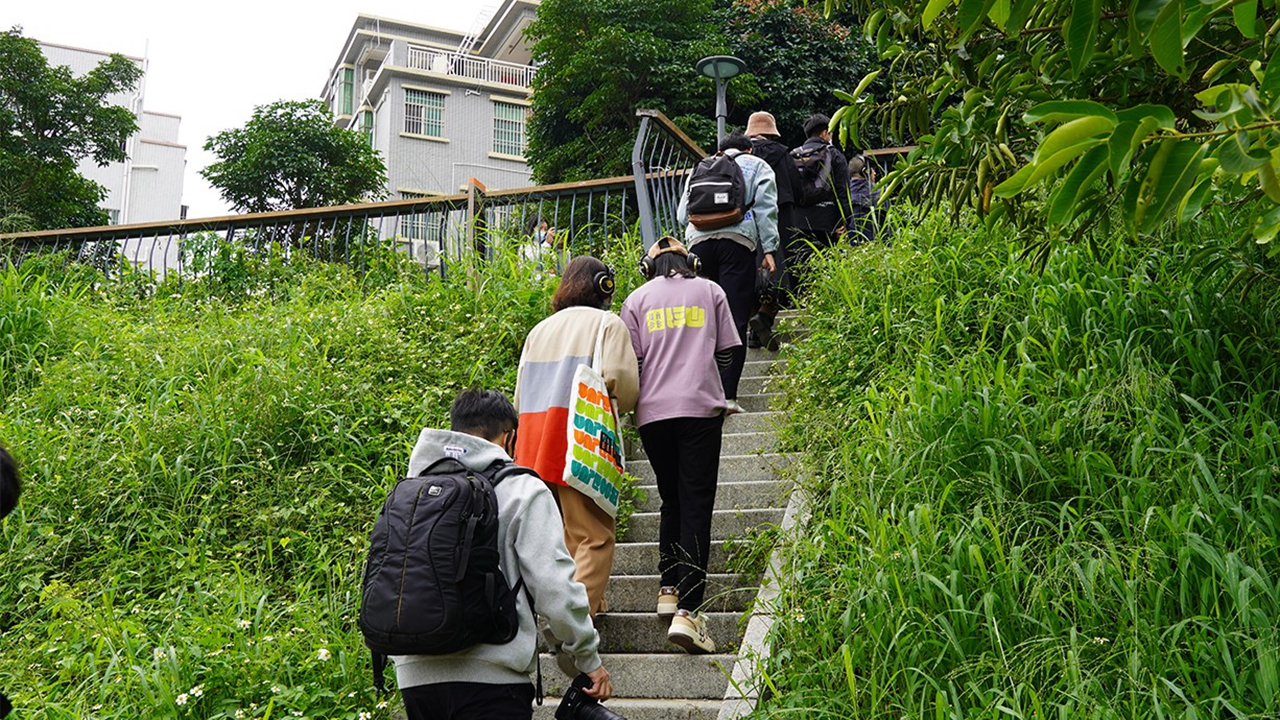
Visitors listen to “Unwalking” while walking at Dawan Ancestral Residence in Pingshan on Dec. 3, 2022. Photos courtesy of SUSTech School of Design: Xu Yingxin & Zhang Yijing
2022年12月3日,参观者们一边漫步坪山大万世居,一边用移动设备聆听“行步如影”项目作品。图片由南科大设计学院许潆心、张奕静提供
Sagesser explained that “Unwalking” means “undo” and “walking.” “We undo or go back in the history of the place where we are walking to uncover things or sounds which normally remain invisible or inaudible.” At the opening of the exhibition Dec. 3, 2022, visitors rambled in the Dawan Ancestral Residence while listening to a piece from the project played on mobile devices. “We would like the public to gain an additional understanding of what Dawan Ancestral Residence is. … When they listen to these projects that our students designed, they get a different experience that actually is sort of oscillating between the past and the future,” said Sagesser.
萨格教授告诉记者,项目的名字“行步如影”是一种回到过去的方式。“我们一边行走,一边回到历史中,发现看不见或听不见的事物或声音。” 2022 年 12 月 3 日,在展览开幕式上,参观者们漫步在大万世居,用移动设备聆听“行步如影”项目作品。“我们希望公众对大万世居有更多的了解。当他们听这些作品时,会有耳目一新的体验,一种介于过去和未来之间的体验,”萨格说。
“It’s not so much that the charm [of sounds] is already there; it depends on what we do with sounds, how we use sounds as an opportunity to actually make something, make an intervention, how we change sounds with technology or create new sounds, so for me that’s where the charm of sounds lies,” he said.
“声音的魅力在于我们如何处理声音,如何利用声音创作或介入,如何用技术改变声音或创造新的声音,对我来说,这就是声音的魅力所在,”他说。
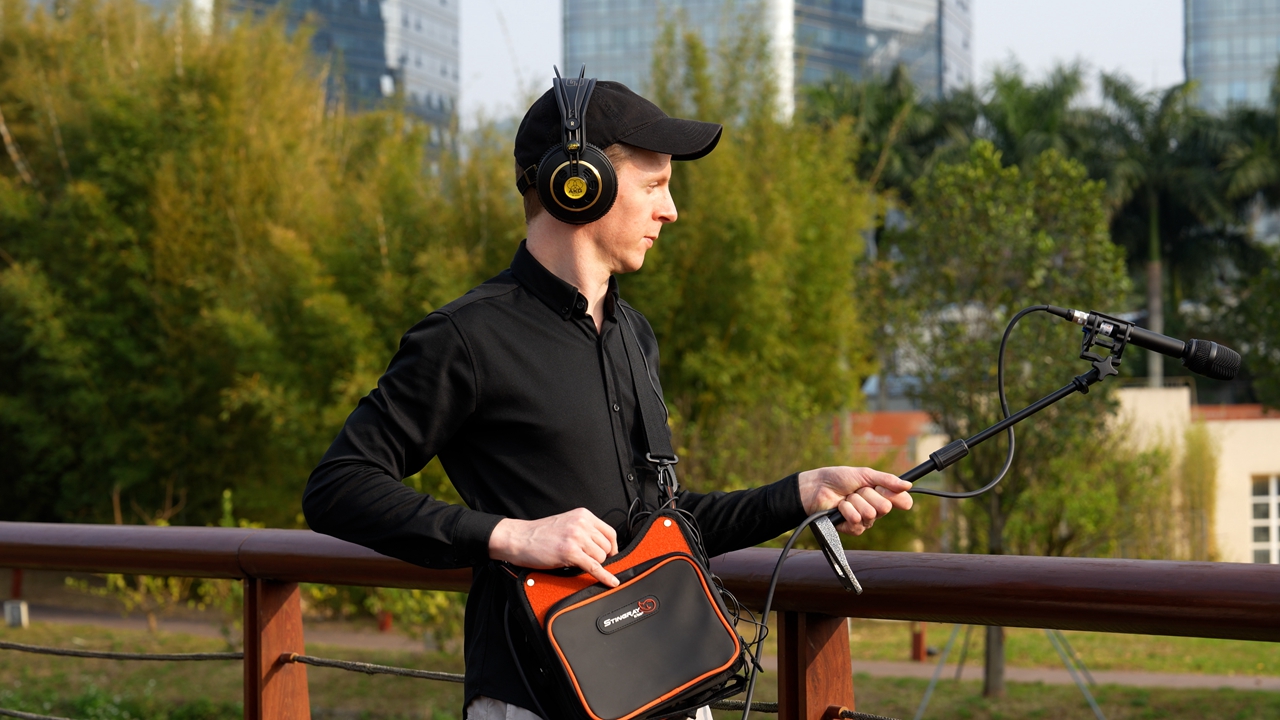
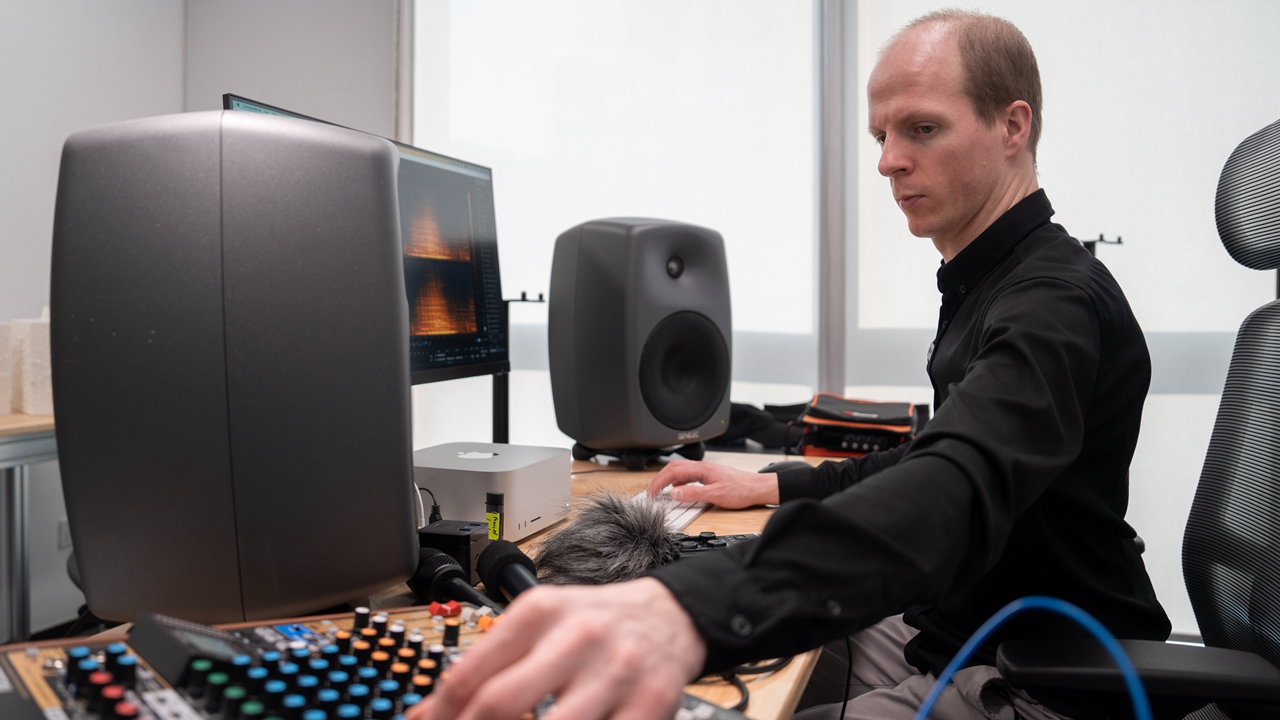
Sagesser processes sound works at his lab at SUSTech.
萨格在南科大的实验室里对收集到的声音进行处理。
In Sagesser’s academic research, he focuses on the manifold ways in which humans craft their relationships with sounding technologies, and how sound is always embedded in a larger socio cultural context. He said that traditionally design was not so much connected with sound, but SUSTech’s School of Design is quite progressive in that it not only designs objects but also focuses on designing experiences for the future.
萨格教授专注于人类与声音技术的多重关系,以及声音如何与庞大的社会文化体系产生联系。他说,传统设计与声音联系不大,但南科大创新创意设计学院相当进步,专注于设计未来的体验。
“Sound research is not so common. … It’s a very special area. … It’s not such a coincidence that Shenzhen would have a job like this, which is the ‘City of Design,’ which is associated with new technologies and developing new technologies, so sound is a huge part of that,” he said. “When I received this offer here and I realized SUSTech is a research university, at the School of Design, I found this to be my best option because it would let me do exactly this kind of research that I want to do.”
“声音研究是一个特殊的领域。深圳有这样的工作,不是巧合,因为这里是‘设计之都’,很多领域与新技术和研发相关,声音研究也是很重要的一部分,” 他说。“当我收到这份工作邀请时,我意识到南科大是一所研究型大学,在创新创意设计学院工作,是我最好的选择,因为这里可以让我做研究。”
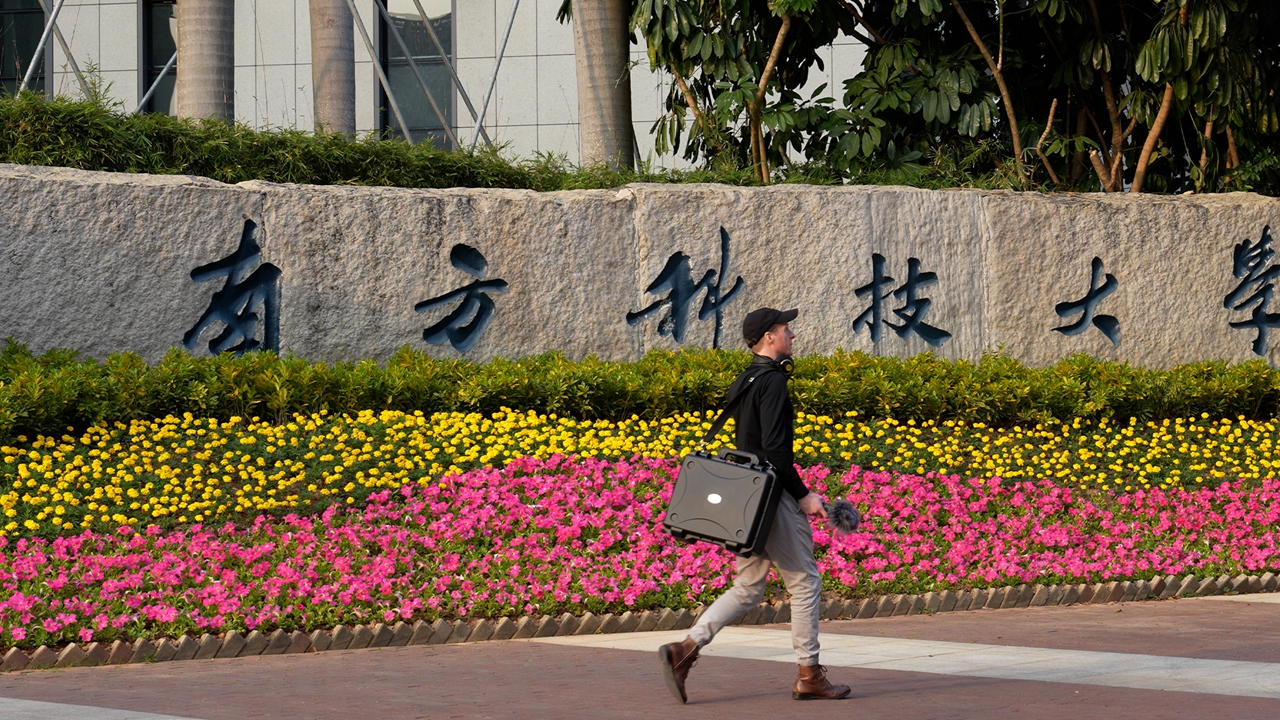
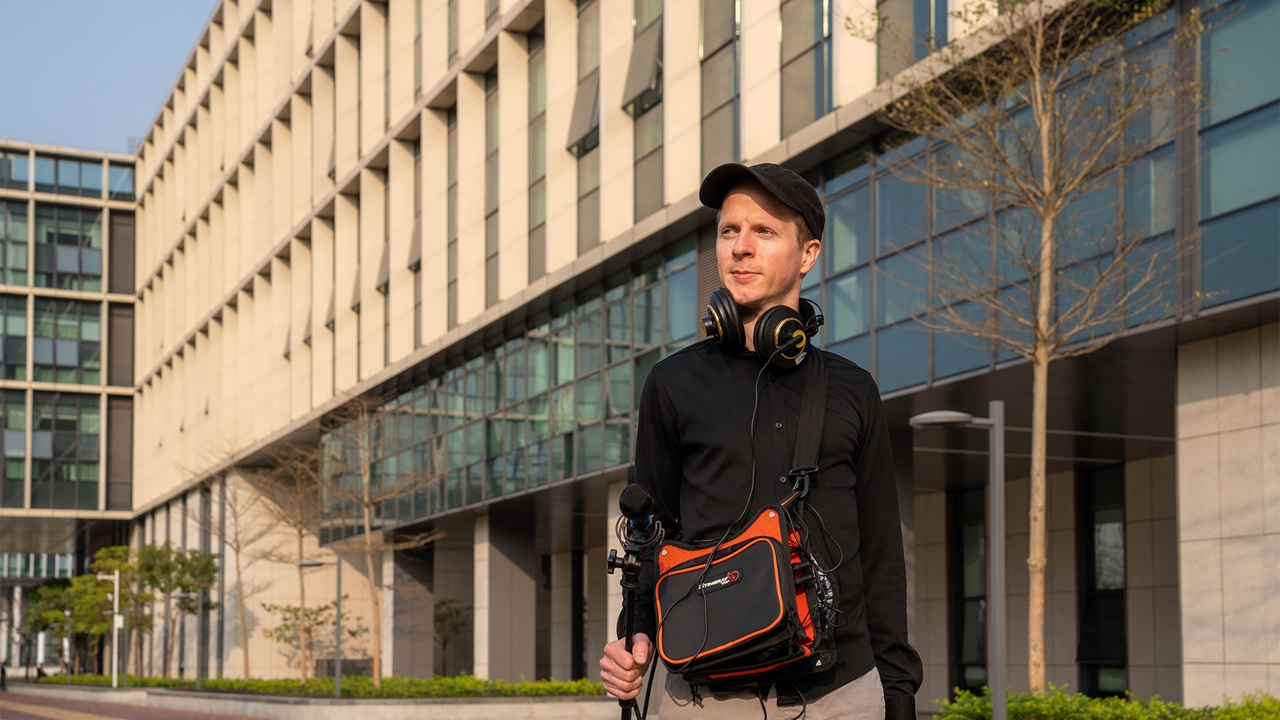
Sagesser walks in the SUSTech campus.
萨格在南科大校园中漫步。
Sagesser holds a Ph.D. in computer music and multimedia from Brown University and master’s degrees in media arts and in music composition from Bern University of the Arts and Zurich University of the Arts, respectively. He has released 11 music albums and exhibited his sound artworks at festivals globally. Last year, he performed with Shenzhen artists at an electronic music gig at Nantou Ancient Town. In Shunde, he just participated in an exhibition, playing a vocal piece in a room full of loudspeakers. The piece was composed based on the sounds he collected at a fish pond in Shunde and the piece was recorded with students from the Chinese University of Hong Kong, Shenzhen.
萨格教授在布朗大学获得了电脑音乐与多媒体博士学位,在伯尔尼艺术大学和苏黎世艺术大学分别获得了媒体艺术和音乐创作硕士学位,目前已出版11张音乐唱片,并参加过多场国际音乐节。去年,他还和深圳艺术家在南头古城演奏电子音乐。最近,他在顺德展出了一首声音作品,这首曲子是他根据在顺德的鱼塘边采集的声音创作,并与香港中文大学(深圳)的学生联合录制。
“The music or the art that I’m creating is always somehow grounded in the research that I’m doing,” said Sagesser. “How can we digitally create new sounds? … Many of my sound works or music works are much more about creating sonic states. … I think the word for this would be ‘sonic architecture.’ It’s like using sound to create a feeling of a place. … You can sit in and be with it, like you sit in a house,” Sagesser explained.
“我的音乐或艺术作品植根于我的研究,” 萨格说。“我们如何用数字技术创造新的声音?... 我的许多声音作品或音乐作品是创造一种声音状态,可以称它为‘声音建筑’,就像用声音来创造一个空间的感觉。你置身其中,像坐在房子里一样,”萨格告诉记者。
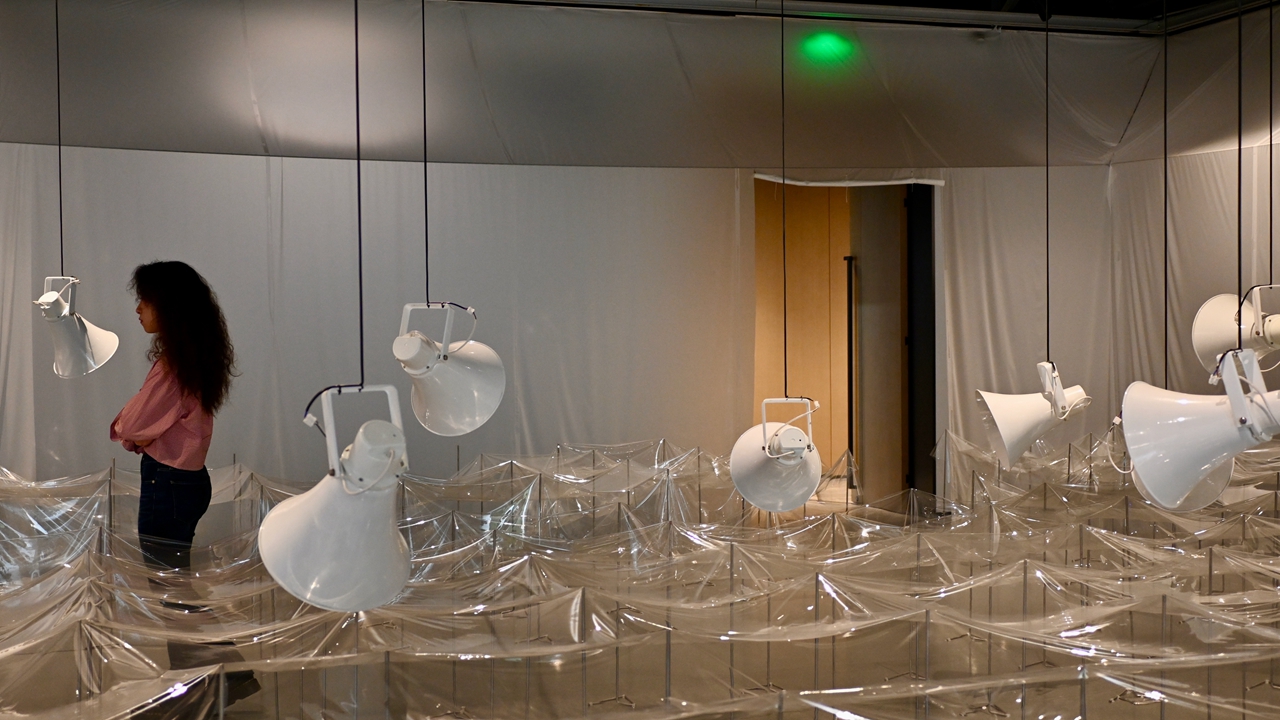
Sagesser’s “In Idle Mode (Noise)” is played in a room full of loudspeakers at an exhibition in Shunde, Guangdong. Photo courtesy of Sagesser
萨格的声音作品《归于悬置——噪音》在于广东顺德美食博物馆举办的展览上播放。图片由萨格提供
Having been in Shenzhen for a year, Sagesser said that the city, “with a subtropical climate and a geographic location between the ocean and the hills, between the ocean and the continent,” has influenced him in many ways. “The water, especially many rivers, the seaside, the Pingshan River, the Dasha River, [has influenced me]. I’ve also started working with hydrophones to record rivers. Also the Pearl River Delta, in and around Guangzhou and Shunde, all of that has changed my research and my artwork.”
在深圳生活一年多,萨格教授认为这座有着亚热带气候的山海之城在很多方面影响了他。“这里的水系,尤其是许多河流、海洋,包括坪山河、大沙河,都影响了我。我现在开始用水听器进行水下录音。另外,珠三角的广州、顺德及周边地区,都改变了我的研究和艺术创作。”
In this visual-dominated world, Sagesser suggests people should pay more attention to the sound because “you will miss a lot of things, information and beauty if you don’t pay attention to the sound. If people have more awareness about the sound, more people will agree that we need better sound design for the city; we need better-sounding trains, better-sounding cars; we need better tools and experiences designed for the city.”
萨格教授希望人们在生活中多关注声音,否则,在这个视觉主导的世界里,“你会错过很多信息和美好的事物。如果人们对声音有更多的认识,大家就会赞同,我们应该为城市设计更好的声音。我们需要为人类带来更好声音体验的火车、汽车、工具等等。”